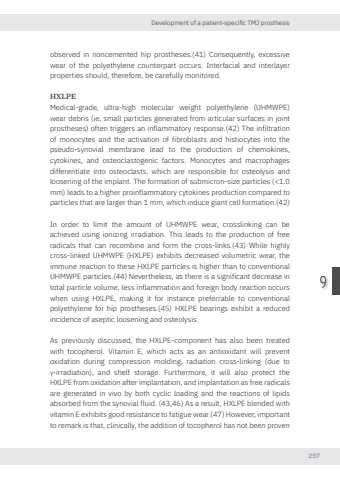Page 259 - Demo
P. 259
Development of a patient-specific TMJ prosthesis2579observed in noncemented hip prostheses.(41) Consequently, excessive wear of the polyethylene counterpart occurs. Interfacial and interlayer properties should, therefore, be carefully monitored.HXLPEMedical-grade, ultra-high molecular weight polyethylene (UHMWPE) wear debris (ie, small particles generated from articular surfaces in joint prostheses) often triggers an inflammatory response.(42) The infiltration of monocytes and the activation of fibroblasts and histiocytes into the pseudo-synovial membrane lead to the production of chemokines, cytokines, and osteoclastogenic factors. Monocytes and macrophages differentiate into osteoclasts, which are responsible for osteolysis and loosening of the implant. The formation of submicron-size particles (<1.0 mm) leads to a higher proinflammatory cytokines production compared to particles that are larger than 1 mm, which induce giant cell formation.(42)In order to limit the amount of UHMWPE wear, crosslinking can be achieved using ionizing irradiation. This leads to the production of free radicals that can recombine and form the cross-links.(43) While highly cross-linked UHMWPE (HXLPE) exhibits decreased volumetric wear, the immune reaction to these HXLPE particles is higher than to conventional UHMWPE particles.(44) Nevertheless, as there is a significant decrease in total particle volume, less inflammation and foreign body reaction occurs when using HXLPE, making it for instance preferrable to conventional polyethylene for hip prostheses.(45) HXLPE bearings exhibit a reduced incidence of aseptic loosening and osteolysis.As previously discussed, the HXLPE-component has also been treated with tocopherol. Vitamin E, which acts as an antioxidant will prevent oxidation during compression molding, radiation cross-linking (due to γ-irradiation), and shelf storage. Furthermore, it will also protect the HXLPE from oxidation after implantation, and implantation as free radicals are generated in vivo by both cyclic loading and the reactions of lipids absorbed from the synovial fluid. (43,46) As a result, HXLPE blended with vitamin E exhibits good resistance to fatigue wear.(47) However, important to remark is that, clinically, the addition of tocopherol has not been proven Nikolas de Meurechy NW.indd 257 05-06-2024 10:14


